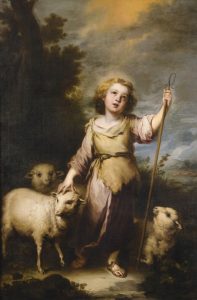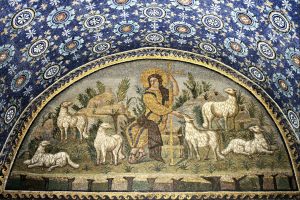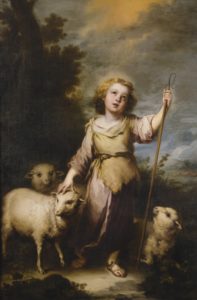Illuminations on the Lectionary readings for April 30, 2023 (Easter 4A)
First Reading: Acts 2:42-47
Every year, the Fourth Sunday of the Easter season comforts us with the image of God as our Good Shepherd, gathering up all humanity in protective divine love.

El Buen Pastor, The Young Christ as the Good Shepherd (1660-1665), oil painting on canvas by Bartolomé Esteban Murillo (1617-1682). Museum of Fine Arts, Boston. (Click image to enlarge)
That metaphor is implicit without being named in Sunday’s first reading from the Acts of the Apostles, the story of the early church as told by the Evangelist we know as Luke. We hear of the evolution of the young church as a caring flock, inspired by the Holy Spirit to become a loving, sharing community, taking care of each other as they pool their resources while sharing the good news of the Gospel with the world.
Psalm: Psalm 23
Our Good Shepherd is always with us, comforting us and protecting us not only in the green pastures and still waters of good times, but also when we are fearful and afraid, walking through the valley of the shadow of death. Did you notice that we sang this Psalm just a few weeks ago, on the Fourth Sunday of Lent? Our Lectionary readings return to it often: Five times in every three years we hear its assurance that God’s goodness and mercy are always with us. When you’re feeling lonely and afraid, try sitting quietly with these verses. Breathe deeply and feel the Shepherd’s comforting presence.
Second Reading: 1 Peter 2:19-25
The Lectionary spares us a disturbing surprise by passing over the verses that precede this reading, but in these times we might do well to face that reality: The writer advises readers to honor the Roman emperor; then issues a startling directive to those who are slaves: “Accept the authority of your masters with all deference, not only those who are kind and gentle but also those who are harsh.” The passage we read today goes on to evoke Isaiah’s Suffering Servant, reminding the early Christians suffering persecution that Jesus suffered and died unfairly, having done no wrong. Like lost sheep, we go astray and suffer, the writer says; but we know joy when we return to Christ, our shepherd and guardian.
Gospel: John 10:1-10
John the Evangelist expands on the shepherd image here as Jesus continues his argument with a group of Pharisees. Jesus calls himself the gatekeeper for the sheepfold, the protective guardian whose familiar voice reassures the sheep. Jesus is further portrayed as the knowing sheepfold gate that opens to allow those protected to enter, while closing to keep out those who would steal, kill and destroy his beloved sheep. Then, in the following verse that we do not read this Sunday, Jesus declares, “I am the good shepherd. The good shepherd lays down his life for the sheep.”



